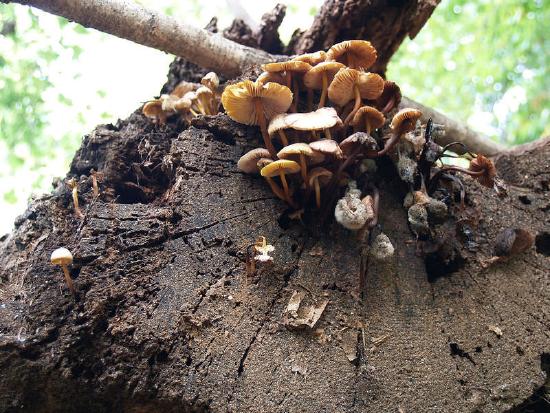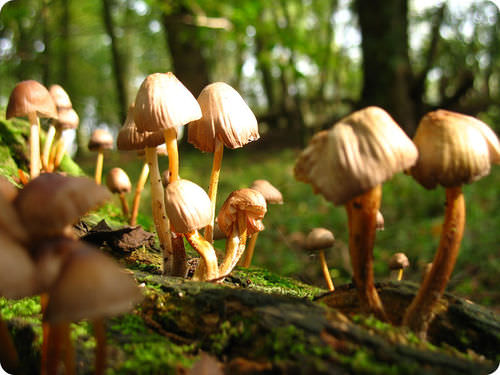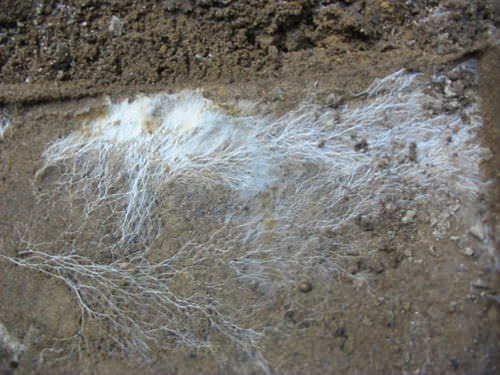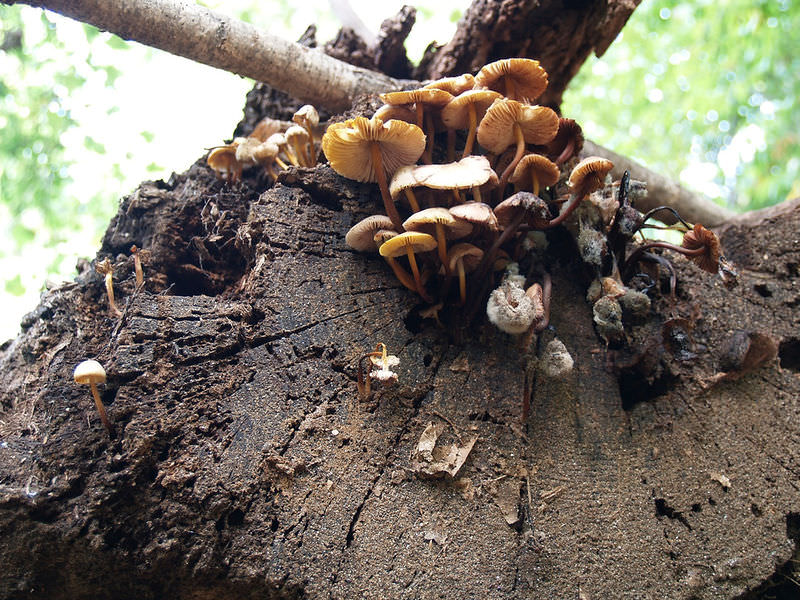8.4: 8.13 Fungi Nutrition
- Page ID
- 12206
\( \newcommand{\vecs}[1]{\overset { \scriptstyle \rightharpoonup} {\mathbf{#1}} } \)
\( \newcommand{\vecd}[1]{\overset{-\!-\!\rightharpoonup}{\vphantom{a}\smash {#1}}} \)
\( \newcommand{\dsum}{\displaystyle\sum\limits} \)
\( \newcommand{\dint}{\displaystyle\int\limits} \)
\( \newcommand{\dlim}{\displaystyle\lim\limits} \)
\( \newcommand{\id}{\mathrm{id}}\) \( \newcommand{\Span}{\mathrm{span}}\)
( \newcommand{\kernel}{\mathrm{null}\,}\) \( \newcommand{\range}{\mathrm{range}\,}\)
\( \newcommand{\RealPart}{\mathrm{Re}}\) \( \newcommand{\ImaginaryPart}{\mathrm{Im}}\)
\( \newcommand{\Argument}{\mathrm{Arg}}\) \( \newcommand{\norm}[1]{\| #1 \|}\)
\( \newcommand{\inner}[2]{\langle #1, #2 \rangle}\)
\( \newcommand{\Span}{\mathrm{span}}\)
\( \newcommand{\id}{\mathrm{id}}\)
\( \newcommand{\Span}{\mathrm{span}}\)
\( \newcommand{\kernel}{\mathrm{null}\,}\)
\( \newcommand{\range}{\mathrm{range}\,}\)
\( \newcommand{\RealPart}{\mathrm{Re}}\)
\( \newcommand{\ImaginaryPart}{\mathrm{Im}}\)
\( \newcommand{\Argument}{\mathrm{Arg}}\)
\( \newcommand{\norm}[1]{\| #1 \|}\)
\( \newcommand{\inner}[2]{\langle #1, #2 \rangle}\)
\( \newcommand{\Span}{\mathrm{span}}\) \( \newcommand{\AA}{\unicode[.8,0]{x212B}}\)
\( \newcommand{\vectorA}[1]{\vec{#1}} % arrow\)
\( \newcommand{\vectorAt}[1]{\vec{\text{#1}}} % arrow\)
\( \newcommand{\vectorB}[1]{\overset { \scriptstyle \rightharpoonup} {\mathbf{#1}} } \)
\( \newcommand{\vectorC}[1]{\textbf{#1}} \)
\( \newcommand{\vectorD}[1]{\overrightarrow{#1}} \)
\( \newcommand{\vectorDt}[1]{\overrightarrow{\text{#1}}} \)
\( \newcommand{\vectE}[1]{\overset{-\!-\!\rightharpoonup}{\vphantom{a}\smash{\mathbf {#1}}}} \)
\( \newcommand{\vecs}[1]{\overset { \scriptstyle \rightharpoonup} {\mathbf{#1}} } \)
\( \newcommand{\vecd}[1]{\overset{-\!-\!\rightharpoonup}{\vphantom{a}\smash {#1}}} \)
\(\newcommand{\avec}{\mathbf a}\) \(\newcommand{\bvec}{\mathbf b}\) \(\newcommand{\cvec}{\mathbf c}\) \(\newcommand{\dvec}{\mathbf d}\) \(\newcommand{\dtil}{\widetilde{\mathbf d}}\) \(\newcommand{\evec}{\mathbf e}\) \(\newcommand{\fvec}{\mathbf f}\) \(\newcommand{\nvec}{\mathbf n}\) \(\newcommand{\pvec}{\mathbf p}\) \(\newcommand{\qvec}{\mathbf q}\) \(\newcommand{\svec}{\mathbf s}\) \(\newcommand{\tvec}{\mathbf t}\) \(\newcommand{\uvec}{\mathbf u}\) \(\newcommand{\vvec}{\mathbf v}\) \(\newcommand{\wvec}{\mathbf w}\) \(\newcommand{\xvec}{\mathbf x}\) \(\newcommand{\yvec}{\mathbf y}\) \(\newcommand{\zvec}{\mathbf z}\) \(\newcommand{\rvec}{\mathbf r}\) \(\newcommand{\mvec}{\mathbf m}\) \(\newcommand{\zerovec}{\mathbf 0}\) \(\newcommand{\onevec}{\mathbf 1}\) \(\newcommand{\real}{\mathbb R}\) \(\newcommand{\twovec}[2]{\left[\begin{array}{r}#1 \\ #2 \end{array}\right]}\) \(\newcommand{\ctwovec}[2]{\left[\begin{array}{c}#1 \\ #2 \end{array}\right]}\) \(\newcommand{\threevec}[3]{\left[\begin{array}{r}#1 \\ #2 \\ #3 \end{array}\right]}\) \(\newcommand{\cthreevec}[3]{\left[\begin{array}{c}#1 \\ #2 \\ #3 \end{array}\right]}\) \(\newcommand{\fourvec}[4]{\left[\begin{array}{r}#1 \\ #2 \\ #3 \\ #4 \end{array}\right]}\) \(\newcommand{\cfourvec}[4]{\left[\begin{array}{c}#1 \\ #2 \\ #3 \\ #4 \end{array}\right]}\) \(\newcommand{\fivevec}[5]{\left[\begin{array}{r}#1 \\ #2 \\ #3 \\ #4 \\ #5 \\ \end{array}\right]}\) \(\newcommand{\cfivevec}[5]{\left[\begin{array}{c}#1 \\ #2 \\ #3 \\ #4 \\ #5 \\ \end{array}\right]}\) \(\newcommand{\mattwo}[4]{\left[\begin{array}{rr}#1 \amp #2 \\ #3 \amp #4 \\ \end{array}\right]}\) \(\newcommand{\laspan}[1]{\text{Span}\{#1\}}\) \(\newcommand{\bcal}{\cal B}\) \(\newcommand{\ccal}{\cal C}\) \(\newcommand{\scal}{\cal S}\) \(\newcommand{\wcal}{\cal W}\) \(\newcommand{\ecal}{\cal E}\) \(\newcommand{\coords}[2]{\left\{#1\right\}_{#2}}\) \(\newcommand{\gray}[1]{\color{gray}{#1}}\) \(\newcommand{\lgray}[1]{\color{lightgray}{#1}}\) \(\newcommand{\rank}{\operatorname{rank}}\) \(\newcommand{\row}{\text{Row}}\) \(\newcommand{\col}{\text{Col}}\) \(\renewcommand{\row}{\text{Row}}\) \(\newcommand{\nul}{\text{Nul}}\) \(\newcommand{\var}{\text{Var}}\) \(\newcommand{\corr}{\text{corr}}\) \(\newcommand{\len}[1]{\left|#1\right|}\) \(\newcommand{\bbar}{\overline{\bvec}}\) \(\newcommand{\bhat}{\widehat{\bvec}}\) \(\newcommand{\bperp}{\bvec^\perp}\) \(\newcommand{\xhat}{\widehat{\xvec}}\) \(\newcommand{\vhat}{\widehat{\vvec}}\) \(\newcommand{\uhat}{\widehat{\uvec}}\) \(\newcommand{\what}{\widehat{\wvec}}\) \(\newcommand{\Sighat}{\widehat{\Sigma}}\) \(\newcommand{\lt}{<}\) \(\newcommand{\gt}{>}\) \(\newcommand{\amp}{&}\) \(\definecolor{fillinmathshade}{gray}{0.9}\)
So what do fungi "eat"?
Just about anything. From dead plants to rotting fruit. Shown here are fungi sprouting from dead material in the woods. Fungi perform an essential role in the decomposition of organic matter and have fundamental roles in nutrient cycling and exchange.
Nutrition
Fungi get their nutrition by absorbing organic compounds from the environment. Fungi are heterotrophic: they rely solely on carbon obtained from other organisms for their metabolism and nutrition. Fungi have evolved in a way that allows many of them to use a large variety of organic substrates for growth, including simple compounds such as nitrate, ammonia, acetate, or ethanol. Their mode of nutrition defines the role of fungi in their environment.
Fungi obtain nutrients in three different ways:
- They decompose dead organic matter. A saprotroph is an organism that obtains its nutrients from non-living organic matter, usually dead and decaying plant or animal matter, by absorbing soluble organic compounds. Saprotrophic fungi play very important roles as recyclers in ecosystem energy flow and biogeochemical cycles. Saprophytic fungi, such as shiitake (Lentinula edodes) and oyster mushrooms (Pleurotus ostreatus), decompose dead plant and animal tissue by releasing enzymes from hyphal tips. In this way they recycle organic materials back into the surrounding environment. Because of these abilities, fungi are the primary decomposers in forests (see Figure below).
- They feed on living hosts. As parasites, fungi live in or on other organisms and get their nutrients from their host. Parasitic fungi use enzymes to break down living tissue, which may causes illness in the host. Disease-causing fungi are parasitic. Recall that parasitism is a type of symbiotic relationship between organisms of different species in which one, the parasite, benefits from a close association with the other, the host, which is harmed.
- They live mutualistically with other organisms. Mutualistic fungi live harmlessly with other living organisms. Recall that mutualism is an interaction between individuals of two different species, in which both individuals benefit.
Both parasitism and mutualism are classified as symbiotic relationships, but they are discussed separately here because of the different effect on the host.
 Forest Decomposers. These forest mushrooms may look fragile, but they do a powerful job. They decompose dead wood and other tough plant material.
Forest Decomposers. These forest mushrooms may look fragile, but they do a powerful job. They decompose dead wood and other tough plant material.Fungal hyphae are adapted to efficient absorption of nutrients from their environments, because hyphae have high surface area-to-volume ratios. These adaptations are also complemented by the release of hydrolytic enzymes that break down large organic molecules such as polysaccharides, proteins, and lipids into smaller molecules. These molecules are then absorbed as nutrients into the fungal cells. One enzyme that is secreted by fungi is cellulase, which breaks down the polysaccharide cellulose. Cellulose is a major component of plant cell walls. In some cases, fungi have developed specialized structures for nutrient uptake from living hosts, which penetrate into the host cells for nutrient uptake by the fungus.
 Fungal mycelia. Fungi absorb nutrients from the environment through mycelia. The branching mycelia have a high surface-area-to-volume ratio which allows for efficient absorption of nutrients. Some fungi digest nutrients by releasing enzymes into the environment.
Fungal mycelia. Fungi absorb nutrients from the environment through mycelia. The branching mycelia have a high surface-area-to-volume ratio which allows for efficient absorption of nutrients. Some fungi digest nutrients by releasing enzymes into the environment.Mycorrhiza
A mycorrhiza (Greek for "fungus roots") is a symbiotic association between a fungus and the roots of a plant. In a mycorrhizal association, the fungus may colonize the roots of a host plant by either growing directly into the root cells, or by growing around the root cells. This association provides the fungus with relatively constant and direct access to glucose, which the plant produces by photosynthesis. The mycelia of the fungi increase the surface area of the plant’s root system. The larger surface area improves water and mineral nutrient absorption from the soil.
Summary
- Fungi are heterotrophic. They get their nutrition by absorbing organic compounds from the environment.
- Fungi, along with bacteria that are found in soil, are the primary decomposers of organic matter in terrestrial ecosystems.
Review
- Describe how fungi obtain nutrients.
- Explain the role of saprotrophic fungi? Give an example of this role.
- What is a mycorrhiza? What are the advantages of a mycorrhiza?
| Image | Reference | Attributions |
 |
[Figure 1] | License: CC BY-NC |
 |
[Figure 2] | Credit: A Bremner Source: http://www.flickr.com/photos/scoobygirl/271283243/ License: CC BY 2.0 |
 |
[Figure 3] | Credit: User:Lex vB/Wikipedia Source: http://commons.wikimedia.org/wiki/File:Zwamvlok_20060705.jpg License: Public Domain |

